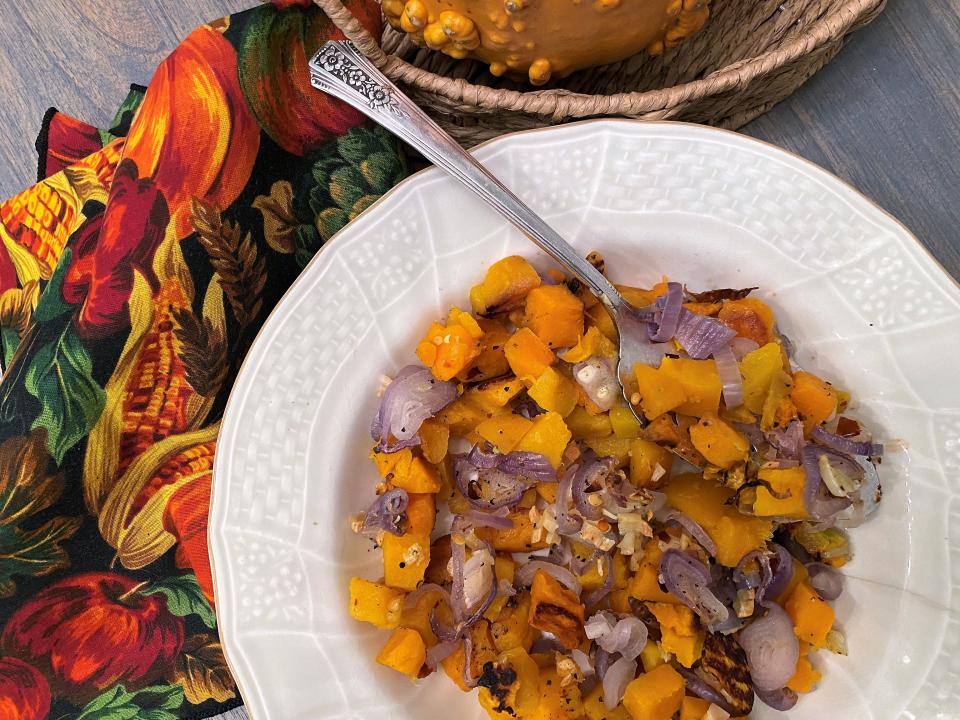Master Gardener: Pumpkins, squash were once crucial to winter survival

According to the Encyclopedia Britannica, squash, (genus Cucurbita), is a genus of flowering plants in the gourd family (Cucurbitaceae), many of which are widely cultivated as vegetables and for livestock feed. Squashes are native to the New World, where they were cultivated by indigenous peoples before European settlement. The fruit of edible species is usually served as a cooked vegetable, and the seeds and blossoms may also be cooked and eaten. Botanically speaking, all types of squash are fruits, as they contain seeds and develop from the flower-producing part of a plant.
Squash was grown in the Mesopotamian Fertile Crescent 8,000 years ago, and they’re part of the Three Sisters Polyculture — corn, beans, and squash — that sustained the rise of the Mayan and Aztec civilizations in Mesoamerica.
Three hundred years ago, growing squash (Cucurbita spp.) was a matter of survival. Winter squash and pumpkins could be stored for months and were an important source of calories and vitamins in the dead of winter.
Winter squash — such as butternut, acorn, Hubbard, delicata, and pumpkin — are abundant from early fall through late spring. They have green, yellow or orange skin and brightly colored flesh in different shades of yellow and orange. Winter Squash Varieties are left on the vine to size up and ripen all summer, harvested in the fall, and eaten all through the winter. Bigger usually is better for winter squash.

Summer squash, including zucchini, patty pan and crookneck, are typically in season from June through September. These varieties have yellow or green skin with white flesh. Harvest summer squash small, while their skins are still thin, and before they’ve developed seed cavities, when they are tender and at their best. Summer squash are vigorous plants, so most, if not all, survive transplanting. Once they start producing, you can’t keep up. If summer squash grows bigger, it becomes mealier (mushier), starchier (less sweet), coarser (more fibrous), stringier, and seedier.
Whether you’re growing summer squash or winter squash, the plants are close cousins and share the same soil, fertilizer, and water needs, the same pests, and diseases. Plant squash in well-draining fertile soil with a PH between 6.0 and 6.5 in full sun. Plants must receive an inch of water during the growing season due to their shallow root system. Plant after the last threat of frost.
There are several problems for the gardener to be aware of. The squash vine borer gets inside the stem and prevents the plant from getting moisture and nutrition from the soil. Keep the lower stems covered with soil to help prevent infestation. Squash end rot is caused by a lack of calcium and can be best prevented by using a calcium-rich fertilizer. Another common pest is aphids, which can destroy plants by eating them before beneficial insects like lady bugs and wasps can get control of them. Neem oil helps control the aphids.
Squash bugs and cucumber beetles can also be quite pesky and are vectors (carriers) of a number of plant diseases that need to be controlled to have a healthy and abundant harvest. Insecticidal soap, plant covers, and hand-picking are all helpful in controlling beetles and squash bugs. You can also try companion plants like marigolds and nasturtium to ward off unwanted bugs. Powdery mildew is a thin white film caused by a fungus that covers the top of leaves and damages and can kill plants by preventing light from being absorbed by the leaves. Downy mildew is a fungal disease that causes a velvety gray growth in the bottom of leaves. Both fungi can be controlled by periodic applications of neem oil.
Both summer and winter squash are quite versatile. Squash can be eaten in a multitude of ways. The entire squash plant is edible, including the flesh, skin, leaves, flowers and seeds. Although the skins of most winter squash are too hard for people to eat, they are often used to feed animals.
Winter squash is best roasted, boiled or steamed
Winter squash is often roasted, boiled, or steamed. It is usually served with butter or olive oil and savory seasonings. You can also add cooked winter squash to salads and soups. Alternatively, try stuffing acorn, delicata or Hubbard squashes with meats, beans, or other vegetables. The seeds of winter squash can be roasted with oil and salt for a crunchy snack.
Zucchini and yellow crookneck squash are usually sautéed, roasted, or grilled with olive oil and garlic, or added to sweet breads and muffins. As they can be spiralized, they have also become a popular low-carb substitute for noodles.
All types of squash are very nutritious and can be a healthy addition to your diet. Winter squashes are typically high in fiber, vitamin A and potassium, while summer squashes are rich in B vitamins and vitamin C.
I must add a reminder that gourds and pumpkins are also members of the squash family. While we don’t eat gourds, they make lovely bird houses as well as functional bowls and dippers. They are frequently used as holiday decorations and are fun to grow to see what kinds of shapes and colors you get in a package of mixed seeds.
Pumpkins also make wonderful decorations as jack-o-lanterns and clustered with corn shocks and other fall foliage. Pumpkins, like other winter squash, are harvested in the fall and people celebrate the harvest and the holidays with pumpkin pie, pumpkin bread, pumpkin soup, pumpkin fritters and…Bon Appetite!
Elaine Bast is a Master Gardener with the Sandusky and Ottawa Counties Office of the Ohio State University Extension Services.
This article originally appeared on Fremont News-Messenger: Master Gardener: Pumpkins, squash were once crucial to winter survival

